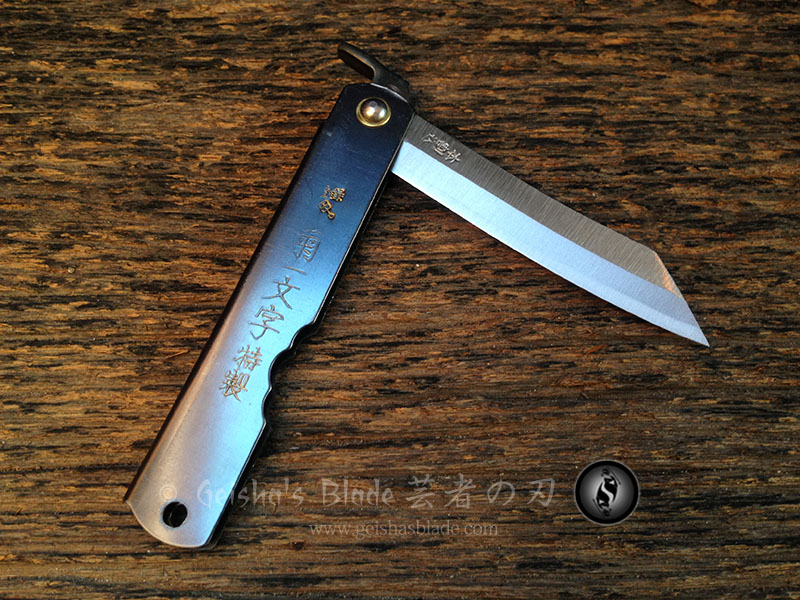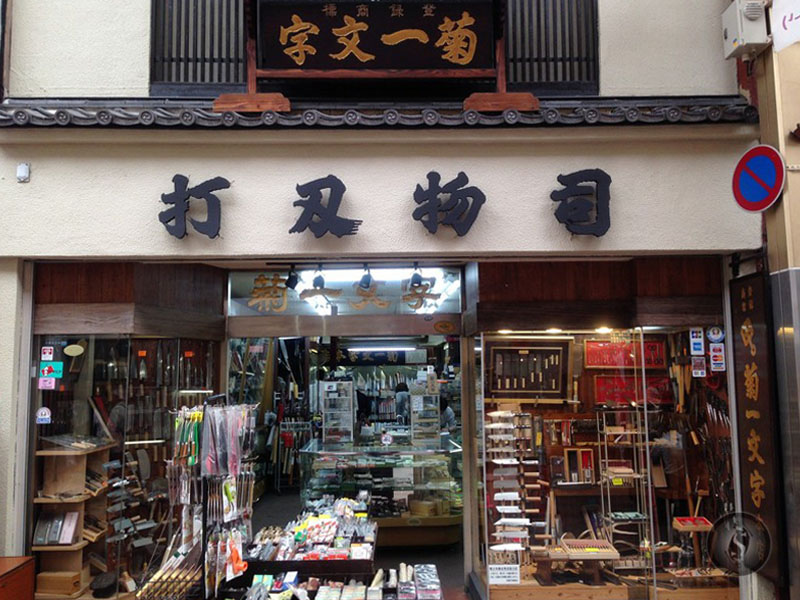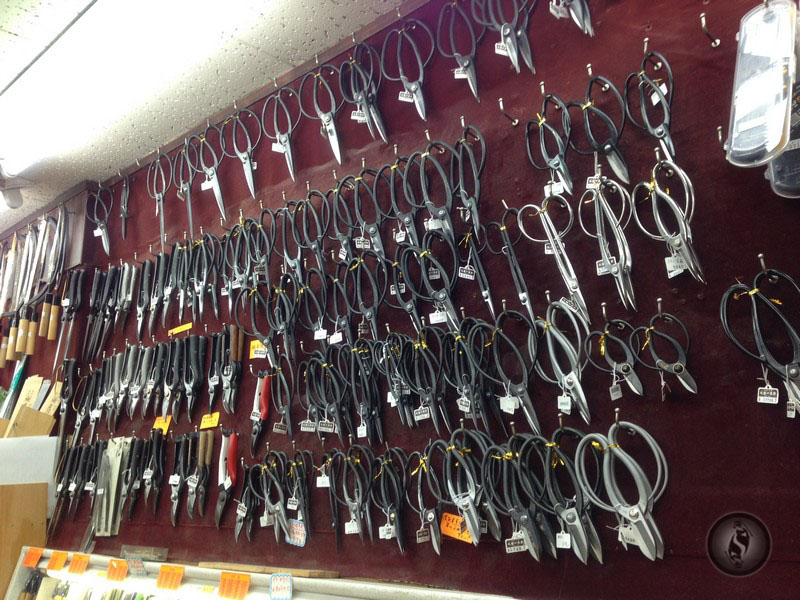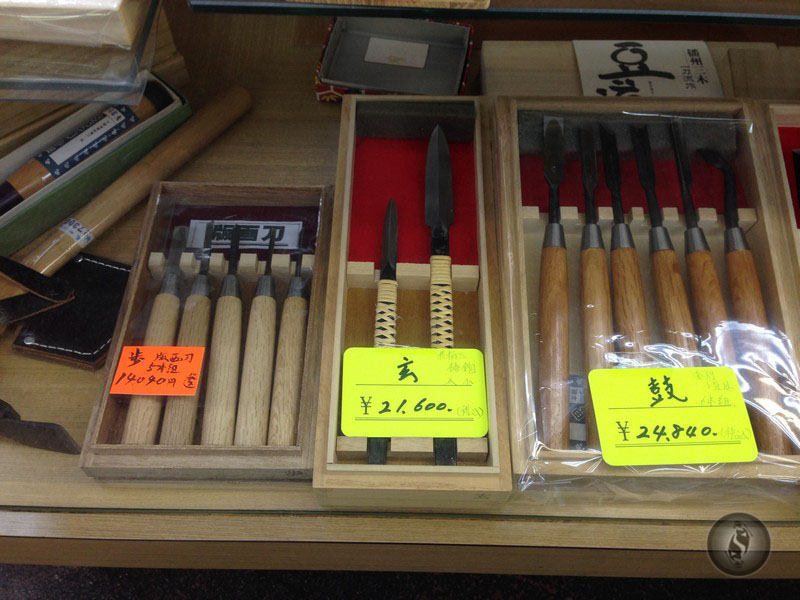Hunt for the Higonokami in Kyoto

Last May 2015, we went to Japan for the purpose of furthering my martial arts training, but because my sensei was still in a different country holding a seminar, we stayed in Kyoto first to wait until he returned to Tokyo in June.
Kyoto was the center of all arts and culture in Japan for centuries. A lot of artisans wanted to relocate to Kyoto to serve the Imperial Household. “Hamono” refers to all kinds of cutting tools such as chef knives, carpenter planes, saws and chisels, sculptor chisels and files, kimono fabric and paper cutting blades, ikebana and gardener clippers, and even modern scissors and fingernail clippers. Kyohamono (Kyoto knives and sharp-edged tools) developed and advanced over the centuries in step with the arts and crafts here.
Though I’m not really a “knife guy”, being in a city where a lot of good bladesmiths are was too good a chance to pass up. I wanted to buy a simple knife that’s made traditionally by hand. I’d been wanting to own a “higonokami” ever since I held one last 2009. This was the perfect opportunity and I grabbed it!
It was our first time to visit Kyoto so we didn’t know where to find a higonokami. We asked some of the staff in our hotel who said that we could buy them in a cutlery store. The thing is, there are a lot of cutlery stores in Kyoto, but only a few sell high quality, truly handmade knives. We then did some research and learned about a certain store called “Shigeharu”.
In this beautiful City of Ten Thousand Shrines, some traditional businesses are considered “senzen” or “before the war”. In most parts of Japan, this refers to World War II, but in Kyoto it may also refer to the Onin War (1467-1477), which set off the Warring States period. Shigeharu is the only Kyohamono company specializing in knives that can claim this title, as Shigeharu’s founding dates back to the Kamakura period (1185–1333).
After visiting Nijo Castle, we headed over to Shigeharu. Along the way, we happened to pass by a small sword shop. As Japanese sword enthusiasts, we had to stop and check out the swords. Here are some of the swords they had on display in their window:
The jitte/jutte on the top tier seems to be a modern reproduction.
Most of these only have a “tsunagi” or wooden blade to hold the “koshirae” (sword mounts). This means the price tag is only for the koshirae without a real blade.
They also have “tsuba” or hand guards available. Having studied about tsuba a bit, I saw that some are old and some are not. Some are fairly priced, while others are just too expensive. Below are some of the good quality antique tsuba:
And here are the “cheap ones” that are still priced very high considering they’re just casts. The shurikens are made of rubber.
Here are even much cheaper tsuba that are made of low quality cast iron. These do not have value to collectors, though they do make fine souvenirs.
I was excited to see that they also have “kogatana” (small knife) together with “kozuka” (handle of the kogatana)! I wanted to buy some but the prices were out of my budget. They also have “kogai” (spike or skewer for arranging the hair) available, but alas, my funds were limited.
I noticed that they also had low priced kogatana with kozuka, so I decided to go inside the store to check them out. Unfortunately, taking photos was not allowed, but I can tell you that there were a lot of old swords and mogito (imitation swords) for sale. I was very much interested in the kogatana with kozuka priced at ¥5,400 (approx PHP 2,000). However, upon closer inspection, I noticed that the blades were made of stainless steel, the kozuka were casts, and the designs were just painted gold and silver. I skipped buying one since they’re just modern reproduction pieces and not really of good quality. They would still make excellent souvenirs and gifts, though. I enjoyed my visit in this small shop as I was able to handle several nihonto.
Still on the way to Shigeharu, we stumbled upon this small thrift shop. They had an assortment of items inside, and they also had the same exact cheap kogatana-with-kozuka from the sword shop we passed by earlier, but selling at a higher price.
We finally arrived at Shigeharu. Outside the small shop, we could hear the sound of a power hammer pounding away. Here are some of the Kyohamono on display:
This is where sharpening and polishing of the blades are done.
I asked one of the staff if they have higonokami for sale, but sadly, they didn’t have it available at the time. They only had a few items inside and it was a bit dark so I wasn’t able to take a lot of photos.
Here’s what the inside of the store looks like when they have a lot of items available (with the owner): Photo courtesy of Tim Turner.
It was a bit of a disappointment that they didn’t have a higonokami available. It was already getting late so we had to call it a day and headed back to our hotel. We researched some more and learned about “Aritsugu”, which is the most popular place for tourists to buy traditional Japanese knives. They are a trusted brand of professionals as well. We went there the very next day. When we arrived at Aritsugu, they had a lot of beautiful knives! Unfortunately, they, too, did not have higonokami available. We didn’t take photos anymore due to our frustration.
My hunt for the higonakami was proving to be a challenge. I decided that I would just look for one when we get to Tokyo since we didn’t have enough time to go around anymore and search for other cutlery shops.
On our last day in Kyoto, we went to Nishiki Market to buy some souvenirs. Jaimee was looking around inside a store so I had to watch over our daughter who’d been running around all day. As I chased after her, I saw a cutlery store. I had to ask Jaimee to watch over our daughter for a while so I can check out the stuff inside. And there, lo and behold, <cue the hallelujahs> I found a lot of higonokami! What a stroke of luck, thanks to my little angel! I was like a kid inside a toy store, beaming from ear to ear, eyes wide and bright! I may have even looked a bit cuckoo. I didn’t care. The store’s name is “Kikuichimonji”.
Kikuichimonji is historic. In the year 1208, the Emperor Gotoba gave permission to his swordsmith Norimune to stamp the blade of each sword with the imperial Chrysanthemum-crest. Norimune then engraved the number 1 below the crest. Thus the name Kikuichimonji, Chrysanthemum One, was created.
In 1876, when samurai were banned from carrying swords, Kikuichimonji added a horse’s bit mouthpiece (kutuwa) logo above its name and started manufacturing cooking knives, carpentry tools, gardening knives, and other related products in Kyoto. Using the superb sword-making technique passed down through generations, Kikuichimonji pledges to produce high-quality cutlery.
Inside, they have a vast selection of knives and other handmade tools. Oooh, it’s just like heaven!
Just like the chef knives, their higonokami are available in different types of steel. Lower priced higonokami are made of non-laminated siro/shiro hagane (white steel), while more expensive higonakami are made of siro/shiro hagane, SW steel, Ao hagane (blue steel), etc. that are honsanmai-laminated with natural hamon.
There were so many tools I wanted to buy: wood planes, chisels, kiridashi, just to name a few, but my wallet was already paper thin after purchasing a lot of higonokami.
Kikuichimonji has a website where you can order Kyohamono, but they don’t sell higonokami online. You can only buy them from the physical store. I think that this is also best as a lot of their stocks are not in perfect condition. I had to thoroughly inspect each higonokami and found many to have burrs and nicks on the edge and tip.
I don’t know much about chef knives to comment on the prices offered by Kikuichimonji, but based on my research, their knives are really of high quality and their prices are lower than Aritsugu. Their whetstones are quite expensive, though!
When we arrived in Tokyo, we visited several cutlery stores and even went to Tokyu Hands (a “one-stop shop” Japanese department store). While they did have a lot of higonokami, or rather, “higonaifu” available, the quality was a far cry from the ones we got in Kyoto. It was truly fortuitous to have found the store and purchase them there!









































